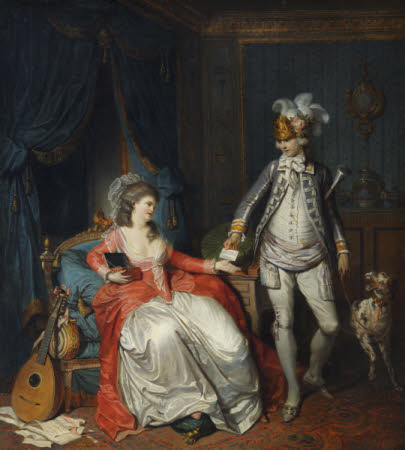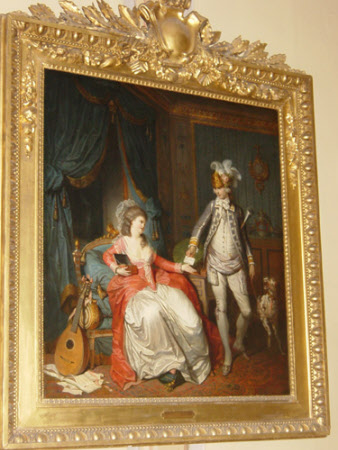Les étrennes de Julie (from Rousseau's La Nouvelle Héloïse)
Pierre Alexandre Wille (Paris 1748 - Paris 1837)
Category
Art / Oil paintings
Date
1783 (signed and dated) - 1783 (exh at Salon)
Materials
Oil on canvas
Measurements
699 x 629 mm (27 1/2 x 24 3/4 in)
Place of origin
Paris
Order this imageCollection
Wimpole, Cambridgeshire
NT 207798
Caption
This picture was acquired by Captain Bambridge of Wimpole, and although there was a tradition of collecting French 18th century paintings in England, this was a singular choice. Instead of the usual graceful mythologies or ‘scènes galantes’ of Boucher and Watteau, he acquired a painting by Wille the Younger of ‘Les Étrennes de Julie’. Exhibited in the Salon of 1783, this is a somewhat fanciful illustration of Jean-Jacques Rousseau’s ‘La Nouvelle Héloïse’ (1761). It shows a messenger, his helmet adorned with emblems of love, bringing New Year’s greetings to the heroine of the novel. Great things were expected of Pierre-Alexandre Wille (1748-1821) by his father, the German-born engraver J.G.Wille, so he not only signed and dated, but also numbered, his pictures to document his output. This is No.72.
Summary
Oil painting on canvas, Les étrennes de Julie (from Rousseau's La Nouvelle Héloïse) by Pierre-Alexandre Wille (Paris 1748 – Paris 1837), signed and dated and numbered, lower right: P.A. Wille filius pxit./1783 no. 72. A youth in rich livery and plumed hat, with a dalmation dog on a lead, enters a room, on the right and hands a letter to a young girl, who is holding a box of jewels and is seated on a bergère, at the side of a bed.The youth, turned into a Messenger of Love by the device of a crossed bow, quiver and roses on a helmet which is topped with white ostrich feathers, wears a white powdered wig and is dressed in a pale coloured coat with frogging and a white linen cravat done in a large bow; the coat is undone to reveal a cream coloured buttoned-up waistcoat and large sash at his waist. He is also wearing breeches, stockings and dainty buckled shoes. He has a silver topped cane tucked under the left arm and leads his dog, a Dalmatian on a scarlet ribbon, held in his left hand, the ribbon is attached to a large dog-collar; the Dalmation is barking and looking up at the youth. In his right hand he holds a folded note, addressed: “A Mademoiselle /Mademoiselle Julie / à Paris’. She is seated on an elaborate, gilded and white bergère upholstered in blue silk with gold tassels. She is full-length, dressed in red satin décolleté polonaise dress with a boned bodice, the dress is opened at the front and worn over a white satin skirt. She also wears a white gauze or lace fichu and the same gathered in bunches at the back of her long hair which falls in a long curl over her left shoulder. Her head is inclined slightly to her left and she looks up at the messenger, her left hand extended to receive the letter, under he left arm she holds a jewel box from which some pearls are spilling. Leaning against the bergère on the left of the picture is a lute which is resting on a sprawl of music sheets. Behind the bergère, on the left is a large bed alcove, with large floor-length blue silk curtains and pelmet, the curtains and pelmet have gold fringes and are tied back with gilt tassels. The letter is addressed to Mademoiselle Julie, the heroine of Rousseau's La Nouvelle Héloïse, originally titled, 'Lettres de deux amans habitans d'une petite ville au pied des Alpes' (Letters from two lovers living in a small town at the foot of the Alps) (1761) of which this picture appears to be a somewhat fanciful illustration. It was exhibited in the 1783 Paris Salon.
Provenance
John Webb, 1920; Raphael sale, Christie's, 20th May 1927, lot 108: bought Tooth; Viscount Kemsley sale, Christie's, 24th March 1961, lot 40; with Leger Gallery, 1961; bought from Leger Galleries, 27 March 1962, for £3, 500; bequeathed by Elsie Kipling, Mrs George Bambridge (1896 - 1976), daughter of Rudyard Kipling, to the National Trust together with Wimpole Hall, all its contents and an estate of 3,000 acres
Credit line
Wimpole Hall, The Bambridge Collection (National Trust)
Marks and inscriptions
signed lower right: P.A. Wille filius pxit./1783 no. 72.
Makers and roles
Pierre Alexandre Wille (Paris 1748 - Paris 1837), artist

